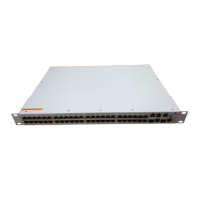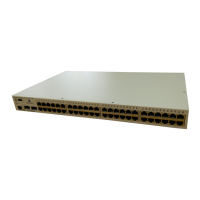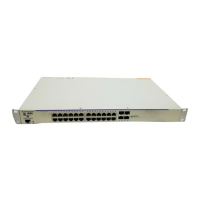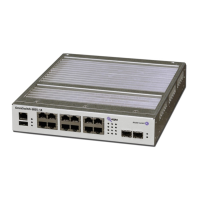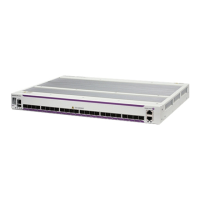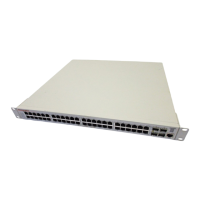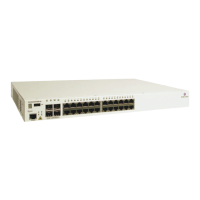
Do you have a question about the Alcatel-Lucent OmniSwitch 6850-U24X and is the answer not in the manual?
| Brand | Alcatel-Lucent |
|---|---|
| Model | OmniSwitch 6850-U24X |
| Category | Switch |
| Language | English |
Lists the OmniSwitch 6850 Series models covered by the guide.
Lists products not covered by this hardware user guide.
Identifies the target audience for this hardware user guide.
Advises on the optimal time to consult the hardware manual.
Outlines the hardware-related information covered in the guide.
Clarifies topics excluded from this hardware user guide.
Explains the structure and flow of information within the guide.
Outlines a roadmap for the user documentation suite.
Lists other relevant user manuals and documentation.
Describes the content and access of the User Manual CD.
Provides information on obtaining technical assistance and support.
Describes safeguards to prevent data flow loss and ensure availability.
Allows return to a prior software version in case of issues.
Explains optional backup power for redundancy.
Describes adding/removing components without powering off.
Details automatic monitoring via sensors and LEDs.
Presents common deployment scenarios for OmniSwitch 6850 Series.
Shows migration path to Gigabit on LAN edge.
Illustrates using the switch for server aggregation.
Depicts use in distribution layer of three-tier networks.
Shows application as core switching for small enterprises.
Details the OS6850-24L stackable switch, its front panel components.
Details the OS6850-48L stackable switch, its front panel components.
Details the OS6850-P24L PoE switch, its front panel components.
Details the OS6850-P48L PoE switch, its front panel components.
Details the OS6850-U24X SFP switch, its front panel components.
Details the OS6850-24 stackable switch, its front panel components.
Details the OS6850-48 stackable switch, its front panel components.
Details the OS6850-24X XFP switch, its front panel components.
Details the OS6850-48X XFP switch, its front panel components.
Details the OS6850-P24 PoE switch, its front panel components.
Details the OS6850-P48 PoE switch, its front panel components.
Details the OS6850-P24X PoE XFP switch, its front panel components.
Details the OS6850-P48X PoE XFP switch, its front panel components.
Explains the front panel LEDs for system status, port status, and power.
Describes LEDs for 10/100/1000 Mbps Ethernet ports.
Describes LEDs for SFP ports.
Describes LEDs for 10 Gbps XFP connectors.
Describes LEDs for second 10 Gbps XFP connectors.
Describes rear panel components like power supply connectors and stacking ports.
Provides instructions and considerations for installing the switch.
Details recommended clearances for proper airflow.
Explains the airflow path through the chassis.
Discusses the importance of blank panels for airflow.
Covers tabletop and rack-mount installation.
Step-by-step guide for tabletop mounting.
Step-by-step guide for rack-mounting the switch.
Instructions for handling SFP modules.
Guides users on how to connect switches for stacking.
How to rack-mount multiple switches in a stack.
Connects switches using stacking cables for a virtual chassis.
Importance of redundant cables for failover.
Explains different ways to connect stacking cables.
Covers the process of powering on switches for operation.
Steps to boot a single switch.
Steps to boot switches configured in a stack.
Details power cord specifications and types by region.
Describes the console port for switch connection and management.
Lists the default serial connection parameters.
How to change serial connection parameters via CLI.
Details pin assignments for various ports.
Introduces the available power supply models and their configurations.
Describes the power supply shelf used for mounting.
Details the 510W AC power supply unit.
Details the 360W AC power supply unit.
Details the 126W AC power supply unit.
Details the 120W DC power supply unit.
Instructions for installing power supplies.
How to connect power supply without a cable.
How to connect power supply using a cable.
Specific notes for DC power supply installation.
How to check the operational status of power supplies.
Lists topics covered in the chapter on PoE.
Provides general specifications for PoE support.
How to check the status of power supplies for PoE.
Covers settings for PoE configuration on the switch.
Lists default configuration values for PoE.
Explains how to change default PoE parameters.
How to enable or disable PoE functionality.
Command to turn off PoE for specific ports or slots.
Sets power limit for individual ports.
Sets power limit for entire slots.
Assigns priority (low, high, critical) to ports for power.
Configures capacitor detection for legacy IP phones.
Explains how the system manages power budget with PDs.
How to enable or disable priority disconnect.
Command to disable priority disconnect.
Command to enable priority disconnect.
Details CLI commands for monitoring PoE status and usage.
Lists topics covered in the chapter on managing stacks.
Introduces stacking concepts and benefits for OmniSwitch 6850 Series.
Defines roles like primary, secondary, and idle modules in a stack.
Explains primary/secondary roles and failover.
Methods for choosing the primary module.
How MAC address determines primary module.
How saved slot numbers determine primary/secondary roles.
How uptime influences primary module selection.
Methods for choosing the secondary module.
Defines the function of idle modules in a stack.
Explains the pass-through state and its causes.
Details how to connect switches using stacking cables.
Importance of redundant cables for failover.
How to verify redundant cable connections.
Explains the importance of unique slot numbers in a stack.
How system software assigns slot numbers.
How to manually assign slot numbers using CLI.
How to clear manual assignments.
Discusses adding or removing modules from a live stack.
Guidelines for removing switches from a stack.
Guidelines for adding switches to a stack.
Procedures for combining multiple stacks.
Explains how to restart switches within a stack.
Process of restarting the primary module.
Process of restarting the secondary module.
How to reload modules in idle status.
How to reload switches in pass-through mode.
Full reboot of the entire virtual chassis.
Guidelines to prevent stack isolation during reloads.
How to manually force the secondary switch to take over as primary.
Process of copying files between management modules for consistency.
Lists CLI commands for monitoring stack status and operations.
Commands to check stack topology, status, and directories.
Commands executable from both management modules.
Using front panel LEDs to monitor stack status.
States compliance with essential EU requirements and directives.
Information on separate collection and treatment of products in EU.
Lists hazardous substances in product components per China RoHS.
Lists safety and EMC standards the product complies with.
Lists various safety certifications and standards.
Lists electromagnetic compatibility standards.
Details FCC Part 15 Class A compliance.
Canada Class A radio noise limits statement.
Compliance with Japan Approvals Institute of Telecommunications.
Warning about potential radio interference.
Compliance with Voluntary Control Council for Interference.
Warning for residential environments causing interference.
Specific grounding and interface requirements for NEBS compliance.
Safety warnings translated into multiple languages.
Warnings about safe lifting procedures for the chassis.
Importance of keeping blank panels installed for airflow.
Precautions during electrical storms.
Only qualified personnel should install equipment.
Warning about invisible laser radiation from ports.
Warning regarding improper replacement of lithium batteries.
Warning about electrical shock risks from power bays.
Warning to disconnect power before servicing.
Requirements for grounding the equipment.
Recommends reading the Getting Started Guide for safety info.
Requirement for installing equipment in restricted access locations.
Importance of grounding oneself before hardware installation.
